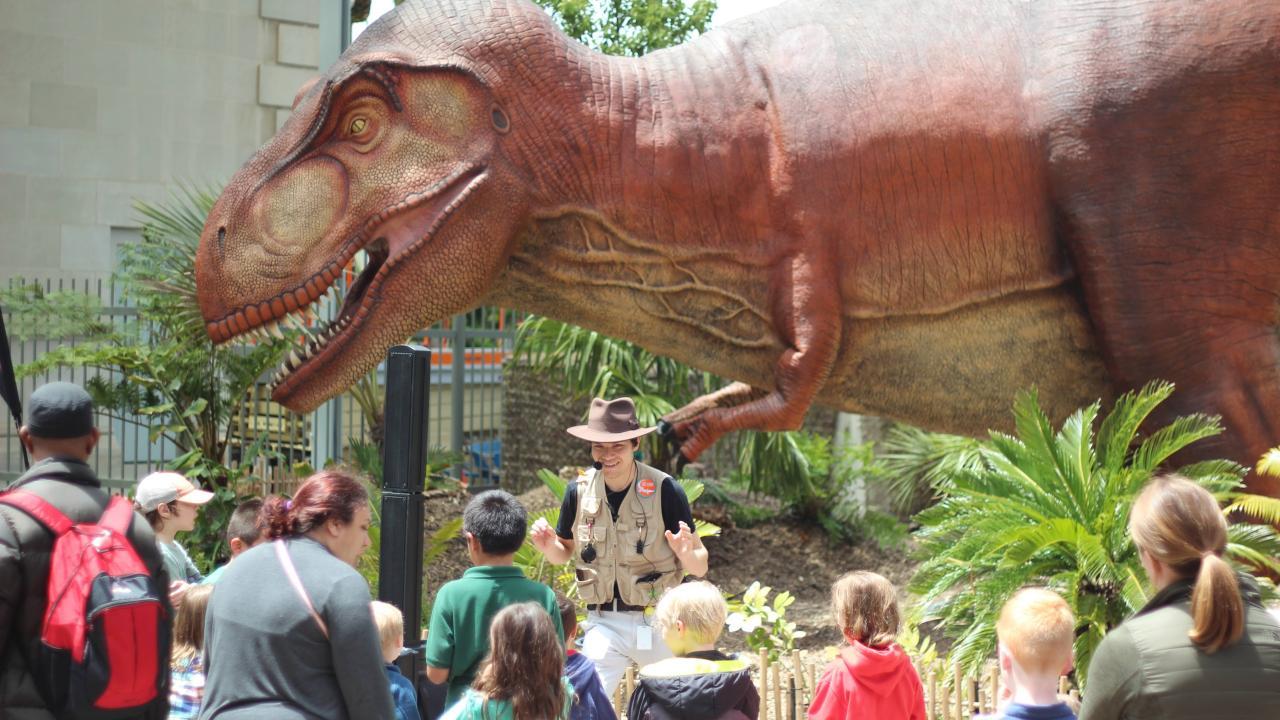
All we have from the non-avian dinosaurs are echoes. Their bones, their footprints, their teeth — they’re all lingering clues to the lives of these magnificent creatures from the past. But to fully visualize them requires imagination.
For UC Davis doctoral candidate Benjamin Faulkner, the necessity of imagination is part of what drew him to paleontology.
“We’re dealing with inanimate objects,” Faulkner said of dinosaurs. “To understand them as living animals, we have to animate them. That can be in our minds, or it can be through movies, or it can be through computer-generated images that we use to understand their locomotion.”
Working in the lab of Professor of Earth and Planetary Sciences Ryosuke Motani, a paleontologist who specializes in functional morphology (the science of linking structure to function), Faulkner is exploring how plant-eating evolved in a group of animals called diapsids, a diverse group of animals that includes dinosaurs, as well as living lizards, snakes, turtles, crocodilians and birds. Specifically, he’s interested in how these animals developed the ability to eat green material, like leaves.
“There are plenty of birds that eat fruits, grains and nuts,” Faulkner said. “That’s relatively easy compared to eating leaves, since they are so much more energy dense. It is really hard to digest green plant material if you have a gut adapted to eating animals.”
Excluding fruits and seeds, only about 2% of existing bird species feed primarily on plants. Lizards fare a smidge better at plant-eating, with about 3% having an essentially herbivorous diet.
“It’s really difficult to eat plants if you don’t start from an ancestor that eats plants, and it turns out, pretty much nobody started out eating plants,” Faulkner said. “So how did these animals overcome this barrier, and why? What are the pathways across different types of diapsids for how they’re evolving herbivory? And are those pathways reflected in the shape of their bodies?”
With his doctoral research, Faulkner hopes to provide clues to help the paleontology community answer these questions.

Looking to the present to understand the past
How does one even begin to infer the dietary habits of creatures long extinct? One avenue of discovery lies in looking at modern-day relatives of those creatures. Take birds and their beaks, for example.
“Birds use beaks for a ton of different things,” said Faulkner, noting that some dinosaur species also possessed beaks but they’re hard to find in the fossil record. "They’re very versatile, but the part of the beak that doesn’t preserve is actually the part that’s interacting with the food. The keratin in their beaks is just like our fingernails. It typically doesn’t preserve, so we don’t have that wear surface to see what the beak was grinding against.”
To circumvent this problem, Faulkner is aggregating observations and data about modern-day diapsids and using that information to make predictions that can be applied to ancient animals.
“Now we can test diets by using statistical tools — we can test them using mechanical tools or modeling on computers,” Faulkner said. “These are all ways that we can get at this problem: What are these ancient animals eating?”

A love for science and scicomm
Faulkner decided to pursue his doctoral studies at UC Davis specifically because of Motani’s status as faculty. Years ago, when Faulkner was an adolescent with a keen interest in all things paleontology, he read a Scientific American article written by Motani called “Rulers of the Jurassic Seas.” The article recounted the evolutionary success of fish-shaped reptiles called ichthyosaurs. It left an indelible imprint on Faulkner.
“I thought Dr. Motani had the skills to help rein in all my ideas,” Faulkner said. “His experience could give me guidance about how to ask the right questions. He’s also very good at picking the right method to analyze a dataset without getting bamboozled through not understanding the limitations and assumptions of that method.”
In addition to being a researcher, Faulkner is also a passionate science communicator. Before starting his doctoral studies, he was a public presenter at the California Academy of Sciences in San Francisco. Today, he co-hosts a podcast called ReelBeasts, which explores the portrayal of prehistoric animals in film.

“We take movies with prehistoric animals in them and explore the filmic side — how did they make this?" Faulkner said. “And also from a scientific perspective, what’s accurate? What’s not?”
Films thus far covered include the Jurassic Park series, The Good Dinosaur and King Kong.
"It’s not about bashing the movie; it’s about the interesting questions these movies bring up,” Faulkner said. “The questions they raise are often interesting. Could King Kong really get this big? What would happen to an animal like that if it did?”
Launched in December 2020, the podcast started as a way for Faulkner to stay in touch with his friend and co-host David Mauro during the coronavirus pandemic. To date, they’ve produced nearly 30 episodes.
“David was in the movie business for a while and has a much better sense of how the industry works,” Faulkner said. “The podcast also gives us the opportunity to have this interplay where my friend David acts as a proxy for listeners who are broadly curious about science.”
For Faulkner, the platform provides an opportunity for him to refine his science communication skills. It also allows him to learn about how filmmakers have portrayed these prehistoric animals through time. That evolution, while not one-for-one, reflects how paleoartists have shifted their portrayals of prehistoric animals to align with the latest research.
“That’s the great part about science: it’s iterative,” Faulkner said. “We can look at reconstructions of dinosaurs from the 1800s, from the 1900s, from the ’50s until now, and we can actually see a reflection of our scientific knowledge through that process. I think that’s really beautiful.”
To learn more about Faulkner, visit his website at https://www.benjaminfaulkner.com
